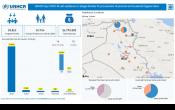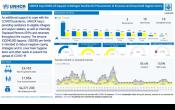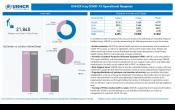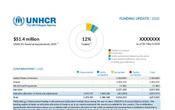Iraq
Operation: Iraq
Location
{"longitude":43,"latitude":33,"zoom_level":0,"iso_codes":"'IRQ'"}
By clicking on the icons on the map, additional information is displayed.
The boundaries and names shown and the designations used on this map do not imply official endorsement or acceptance by the United Nations.
Key Figures
| 2019 year-end results | |
| 292,800 | people of concern received core relief items, with distribution focused, inter alia, on births, new arrivals in camps and marriages |
| 99,300 | IDP, returnee and refugee families received seasonal cash support |
| 47,200 | IDPs and returnees received legal assistance, with 36,600 obtaining civil documentation |
| 18,700 | IDP, returnee, and refugee families received multipurpose cash assistance |
| 10,500 | emergency shelters were provided for IDP and refugee families |
| 2020 planning figures | |
| 143,240 | refugee and IDP households receive cash grants |
| 108,500 | people of concern gain legal assistance |
| 7,700 | people of concern benefit from civil status registration or documentation |
Latest Updates and Related Links
People of Concern
30%
Decrease in
2019
2019
| 2019 | 2,180,062 |
| 2018 | 3,092,425 |
| 2017 | 4,501,786 |

[["Refugees",273992],["Asylum-seekers",12938],["IDPs",1414632],["Returned IDPs",431130],["Returned refugees",101],["Stateless",47253],["Others of concern",16]]
Loading ...
Iraq
< Back
2019
{"categories":[2015,2016,2017,2018,2019,2020],"budget":[556.0649220800001,546.94595405,557.0937608659999,559.82611683,602.477448437,538.64381787],"expenditure":[266.34543259000003,338.02568545,252.37669675,213.92686105,203.02508774,null]}
{"categories":[2015,2016,2017,2018,2019,2020],"p1":[136.09662109,116.48767369,137.52939031,135.89173072,185.67386308000002,194.77846032],"p2":[2.0459883999999997,0.80424081,0.623739,0.307821,0.46577978999999997,0.93430746],"p3":[35.763788049999995,26.70785472,null,null,null,null],"p4":[382.15852454000003,402.94618483,418.94063155599997,423.62656511,416.337805567,342.93105009]}
{"categories":[2015,2016,2017,2018,2019,2020],"p1":[102.03521415,98.77158239,78.07126444,72.24820125,72.21031726000001,null],"p2":[1.499491,0.30823717,0.26725107,0.23696317,0.26995740999999995,null],"p3":[11.329619560000001,1.89021959,null,null,null,null],"p4":[151.48110788,237.0556463,174.03818124,141.44169663,130.54481307,null]}
Loading ...
CHOOSE A YEAR
- 2014
- 2015
- 2016
- 2017
- 2018
- 2019
- 2020
Operational context
The overall security and political situation in Iraq remained stable until the last quarter of 2019, when mass demonstrations erupted across the central and southern governorates, resulting in the resignation of the Prime Minister. The escalation of hostilities between major actors in the region, coupled with the ongoing protests, resulted in a fragile security and political context that compromised the stability, transition, and reconciliation efforts achieved thus far. UNHCR’s access to people of concern in certain locations was affected as a result of these events. Moreover, following military operations in the north-east of the Syrian Arab Republic (Syria) in mid-October, more than 17,000 Syrian refugees fled into Iraq, requiring the operation to redirect significant resources to address the emergency.Protection risks for displaced people remained acute, with many IDP and returnee families affected by physical insecurity, limited freedom of movement, confiscation of documents, detention, forced evictions and an increased risk of sexual and gender-based violence. Poor economic conditions further hindered the access of many families to medical care and adequate shelter, occasionally leading to negative coping mechanisms. Likewise, thousands of refugee families had limited livelihood opportunities, which translated into poor economic conditions and increased protection concerns. The protracted presence of refugees, as well as the influx of Syrian refugees, further stretched existing public services.
Population trends
By the end of 2019, there were a total of 1.4 million IDPs; 4.6 million returnees (between 2014 and 2019); 286,900 refugees and asylum-seekers; and 47,300 stateless persons in Iraq.The IDP population decreased by 388,200 individuals during the year, 38% of whom previously resided in camps. Of the total 1.4 million individuals who remained internally displaced, 63% lived in private accommodation, with the remaining 37% residing in one of the 67 IDP camps across Iraq. While no official figures were available, it was estimated that some 4,200 Iraqi refugees returned from Syria and Turkey during the year.
Out of the total 286,900 registered refugees and asylum-seekers, 245,800 were Syrian and the remaining 41,100 were of other nationalities (mainly Turkish, Iranian, Palestinian, and Sudanese). Most Syrian refugees (99%) lived in the Kurdistan Region of Iraq, 71% of whom were women and children.
Achievements
- UNHCR successfully accommodated over 17,000 refugees fleeing the north-east of Syria by renovating and expanding two camps and supporting registration activities to enable refugees to move out of camps.
- Following UNHCR advocacy, the Iraqi Ministry of Interior decided to register Syrian refugees under the 1971 Political Refugee Act at the federal level, providing them with increased protection from refoulement and freedom of movement.
Unmet needs
- The operation was 32% funded at the end of 2019.
- Access to civil documentation remained a challenge for thousands of IDPs and returnees.
- Further interventions were needed to support reconciliation and reconstruction effort to ensure the reintegration and access to essential services for returnees.
- Large gaps remained in addressing the increasing needs of displaced people in Iraq, both in terms of emergency humanitarian responses and development activities.
Operational Environment
The Government of Iraq declared in December 2017 that it had regained control of all Iraqi territory from extremist groups. However, the needs of the affected population remain high. There are almost 1.9 million people currently internally displaced from the conflict, which began in 2014. According to the International Organization for Migration’s displacement tracking matrix, there are close to 4.1 million IDP returnees. Many families continue to face constrained access to basic services, and security and protection risks while contending with destroyed properties and critical infrastructure, and the lack of livelihood opportunities and financial resources. In some instances, this has led to secondary displacement. There is need for continued support to the displaced population and extensive reconstruction to allow for sustainable return.UNHCR leads the Protection, Camp Coordination and Camp Management (CCCM), and Shelter/Non-Food items clusters, as part of the cluster coordination mechanism for the IDP response, and co-leads the Working Group on Sustainable Solutions for IDPs within the Resilience and Recovery Programme (RRP) with UN Habitat. UNHCR will continue to engage governmental, humanitarian and development actors to transition IDP issues into development plans, and support a gradual absorption of needs-based assistance into the Iraqi social welfare system.
UNHCR collaborates with the Government of Iraq and Kurdistan Regional Government to assist refugees and asylum-seekers, and on statelessness prevention and response. Through the Regional Refugee and Resilience Plan (3RP), UNHCR leads the humanitarian response for Syrian refugees in coordination with authorities. UNHCR advocates with authorities to maintain open borders and ensure access to safety.
Key priorities
In 2019, UNHCR will focus on:- Providing core assistance, including in-kind and cash-based assistance to the most vulnerable individuals, maintaining efforts to explore all viable options to transition out of humanitarian interventions and pursue the systematic inclusion of people of concern into development plans;
- Mainstreaming sexual and gender-based violence (SGBV) response programmes into non-food item, shelter, and camp management activities, and increasing monitoring and access to quality response services across Iraq;
- Providing free legal services for those in displacement and in areas of return;
- Ensuring adequate shelter through prioritizing construction and repair of shelters for the most vulnerable IDP families;
- Advocating with the Government to develop a national legal framework for refugee protection and provide technical support to the authorities to enhance the protection environment for Syrian and non-Syrian refugees and asylum-seekers.
































